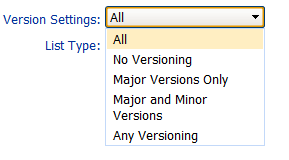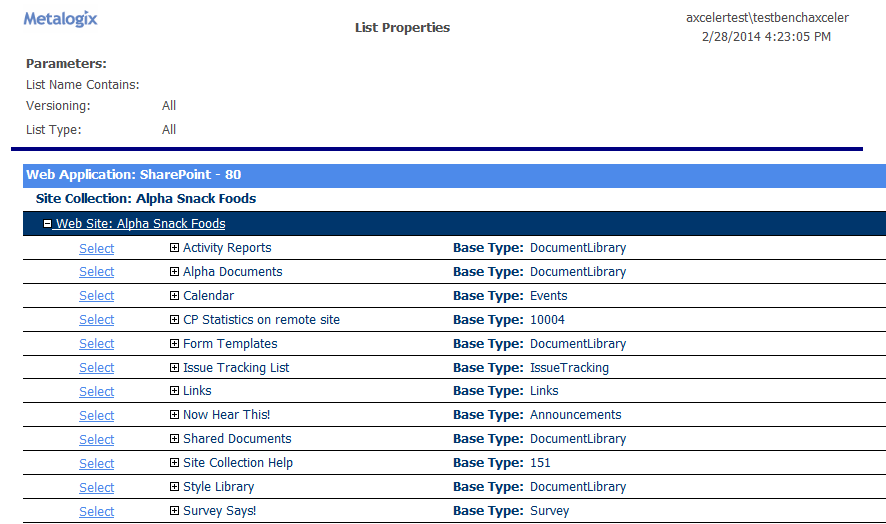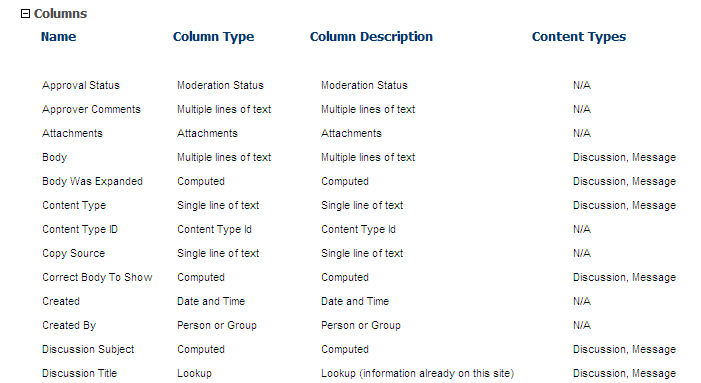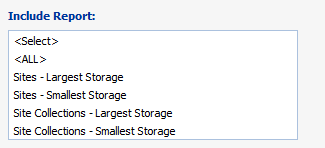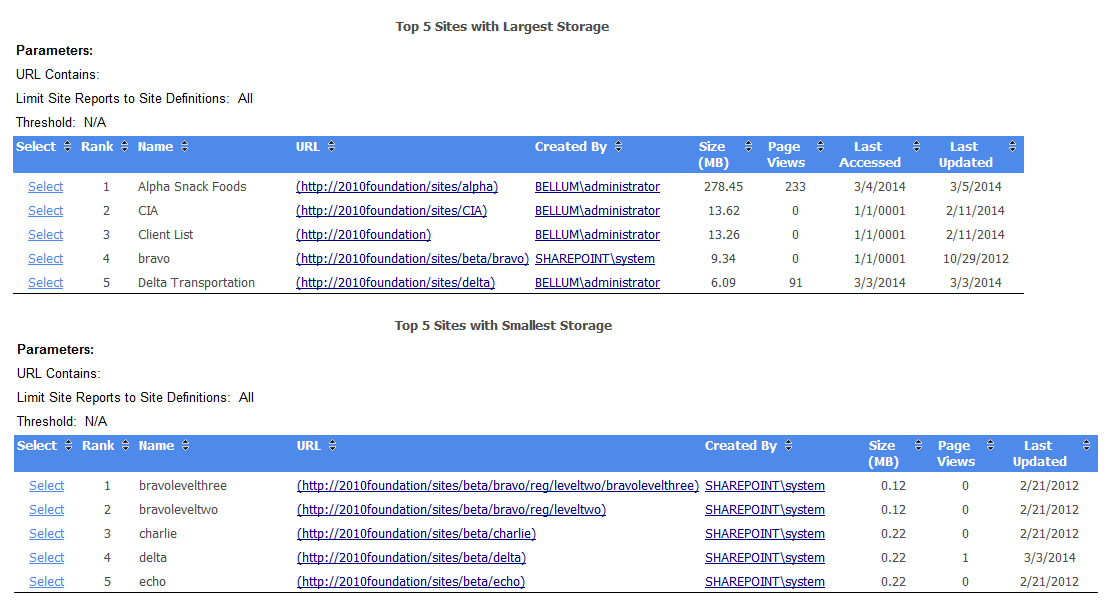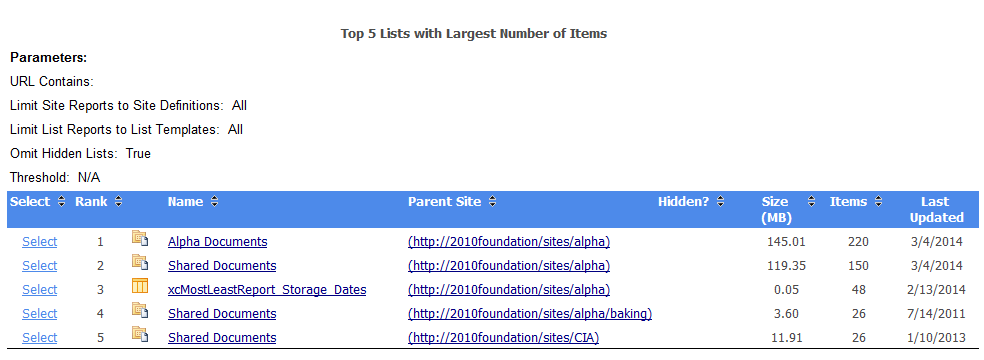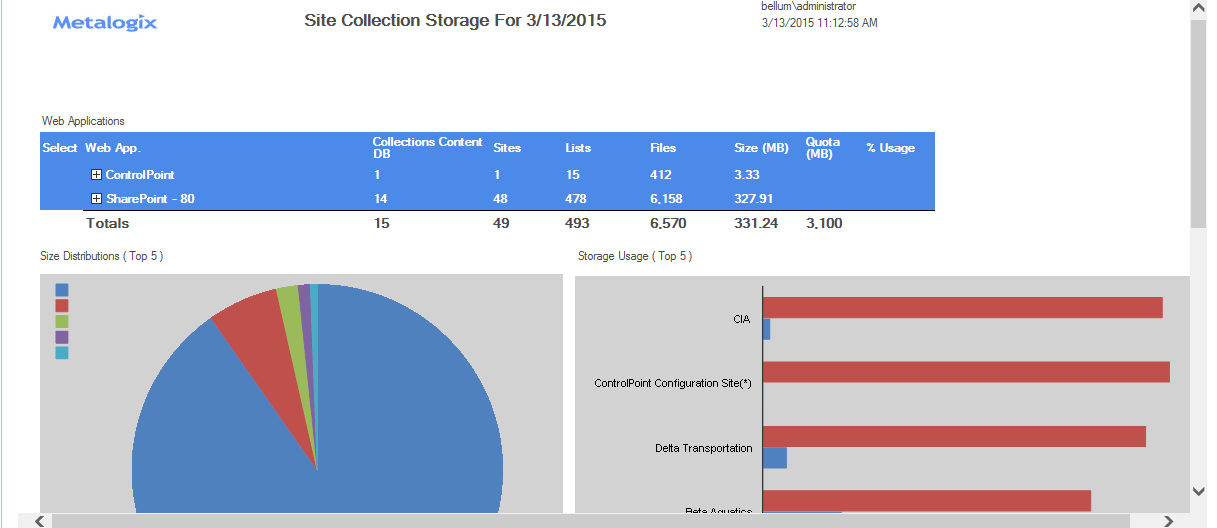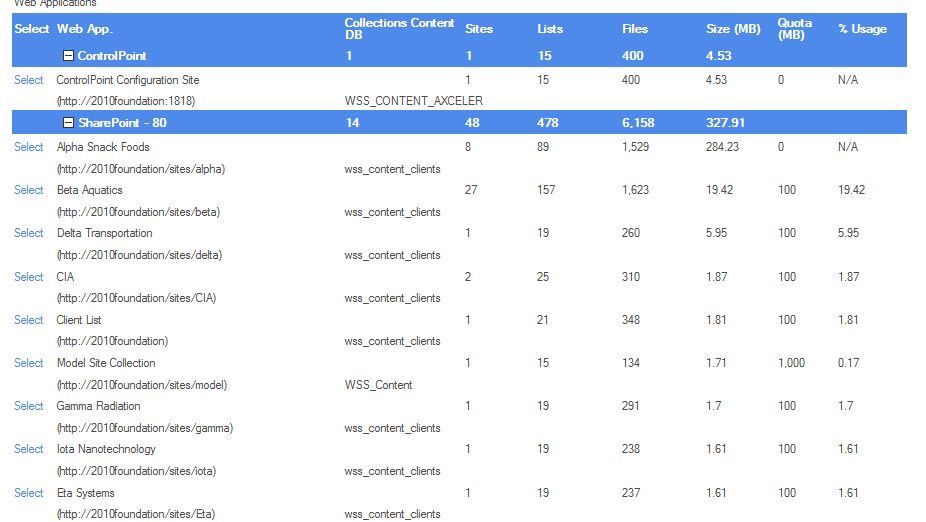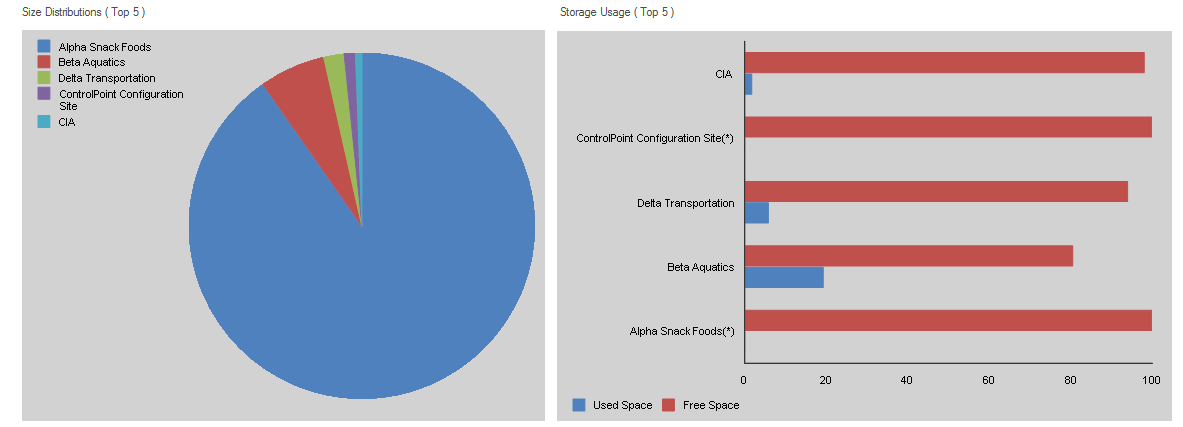Analyzing List Properties
The List Properties analysis provides information about one or more lists in your farm, including:
·the properties of the list, including versioning and advanced settings
·audit settings that are/are not enabled for the list.
To generate a List Properties analysis:
1Select the object(s) you want to include in your analysis.
2Choose Configuration > List Properties.
3If you want results to include only lists that meet one or more specific criteria, specify one or more of the parameters described in the following table.
|
If you want results to include only lists... |
Then ... |
|---|---|
|
whose name contains a specific text string |
enter the text string in the List Name contains field. |
|
that have a particular version setting |
select from the Versions Setting drop-down. |
|
of one or more specific types |
select from the List Types drop-down. |
Now you can:
·run the operation immediately (by clicking the [Run Now] button)
OR
·schedule the operation to run at a later time or on a recurring basis.
OR
·save the operation as XML Instructions that can be run at a later time.
The top level of the analysis lists each Web application, site collection, site, and list within the scope of your analysis, along with the list's Base Type.
When expanded, the following information is displayed for each list:
·list Properties, including versioning and advanced settings detail
·all of the available Audit Settings, with settings that are currently enabled for the list identified by a plus sign (+).
NOTE: Audit settings that are inherited from the site collection are flagged with >.
·list Columns settings
Analyzing Storage
ControlPoint offers the following analyses that enable you to examine storage usage for a specific date or time period:
·Most/Least Storage analysis lets you examine site collections, sites, lists, and list items that are using the most and/or least amount of storage space.
·Site Collection Storage Analysis shows storage usage for one or more site collections.
·Site Storage Analysis shows storage usage for sites within one or more site collections.
·Content Database Storage shows current information about content databases used by site collections in your SharePoint farm.
·Site Lists and Libraries Storage shows storage usage for each individual page and document within a site.
·Storage by File Type shows the amount of storage used by file extension.
You can also analyze trends in storage use over a specified time period. See Analyzing Trends.
In addition, the Duplicate Files Report lets you locate files across lists and libraries in your farm that have the same file name, extension, and relative size. You can use this information to help you free up storage space in content databases.
Analyzing Most/Least Storage
Use the ControlPoint Most/Least Storage analysis to examine SharePoint objects (site collections, sites, lists, and/or list items) within a selected scope ranked according to those using the most or least amount of storage.
You can further narrow your result set to include only objects that meet specific criteria and/or thresholds.
To generate a Most/Least Storage analysis:
1Select the object(s) for which you want to analyze most/least storage.
2Choose Storage > Most/Least Storage.
3Specify the parameters for your analysis:
a)Select the object types you want to analyze:
§Site Collections and Sites
OR
§Lists and Files
Note that remaining parameters are populated based on the object type selected.
b)From the Include Report list box, select the type(s) of storage that you want to include in your analysis.
NOTE: If you choose multiple storage types, each result set will be displayed in a separate subsection.
c)If you want to limit each result set to more or less that 10 objects, change the default value for Limit Results to number of Objects field.
NOTE: This field cannot be left blank.
d)If you want to limit each result set based on the amount of storage used, complete the Limit results to the amount of Storage used (in MB) field.
NOTE: If your analysis includes "most" storage, results will include objects at or above that limit; for "least" storage, results will include objects at or below that limit. If you leave the field blank, no storage size limit will be applied.
e)If you are reporting on Lists and Files and you want to limit each result set based on number of items within a list, complete the Limit results to number of List Items per List field.
NOTE: If your analysis includes "most" storage, results will include lists with the specified number of items or more; for "least" storage, results will include lists with the specified number of items or fewer. If you leave the field blank, no limit will be applied.
4If you want to further refine your results, expand the Advanced Options tab.
a)If you want to limit your result set to objects that meet one or more specific criteria, use the information in the following table for guidance.
|
If you want to limit each results set... |
Then ... |
|---|---|
|
to objects with one or more specific site definitions (templates) |
select from the Limit Site Reports to Site Definitions list. |
|
to objects whose url contains a specified text string |
enter that string in the Limit results to objects whose URL field. NOTE: If your analysis includes multiple types, this limit will apply to each individual result set. |
|
For Documents, Pages, and Users: | |
|
to lists of one or more specific list definitions |
select from the List Definitions list. |
|
to exclude lists that do not display in the site's View all Site Content page |
check the Omit Hidden Lists box. NOTE: If you choose to include hidden lists in analysis results, they are flagged in analysis results with a plus sign (+). |
Now you can:
·run the operation immediately (by clicking the [Run Now] button)
OR
·schedule the operation to run at a later time or on a recurring basis.
OR
·save the operation as XML Instructions that can be run at a later time.
The body of the analysis includes a subsection for each usage type, as shown in the following examples:
Largest and Smallest Storage Used (Sites)
Largest Number of Items (Lists)
Analyzing Site Collection Storage
The Site Collection Storage Analysis provides storage statistics for selected site collections, including:
·the distribution of storage among Web applications selected for analysis, and
·the number of top site collections (that is, site collections with the scope of your analysis using the most storage).
To generate a Site Collection Storage Analysis:
1Select the object(s) on which you want to perform the analysis.
2Choose Storage > Site Collection Storage Analysis.
3Specify the parameters for your analysis.
Note that, in addition to the "standard" parameters, a Limit display to must be specified. The value in this field (which is 10 by default, but may be changed), represents the number of sites using the most storage space that you want to examine more closely. These sites are listed in a separate section at the bottom of the analysis results.
Now you can:
·run the operation immediately (by clicking the [Run Now] button)
OR
·schedule the operation to run at a later time or on a recurring basis.
OR
·save the operation as XML Instructions that can be run at a later time.
The Site Collection Storage analysis consists of the following sections:
·Web Applications
·Size Distributions
·Storage Usage
·Top Site Collections
Web Applications Section
The Web Applications section lists the Web application(s) within the scope of your analysis, along with the following statistics for individual Web applications and cumulative totals:
·the number of site Collections, Sites, Lists, and Files.
·the Size, in megabytes (MB) of storage used.
NOTE: Size includes content but excludes logs, metadata and other storage overhead. It is not meant to reflect the size of the content database.
When expanded, these statistics display for individual site collections, along with:
·the Content DB used by the site collection
·Quota in megabytes (MB)
·%Usage relative to the quota..
Size Distributions and Storage Usage Sections
The Size Distributions section consists of a pie chart that depicts the size distribution among the Web applications within the scope of your analysis. (If you generated the report for a single Web application, the chart will appear solid.)
The Storage Usage section consists of a bar chart that shows the amount of storage space used by each Web application relative to the Web application's quota.
NOTE: If a quota has not been set for the Web application, Used Space will not be captured.
Top Site Collections by Size
This section shows statistics for the site collections using the most storage space. The number of site collections that display in this section is determined by the value you specified for Limit display to.


